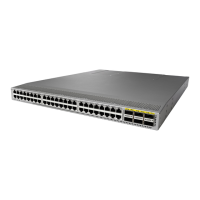Send document comments to nexus3k-docfeedback@cisco.com
9-6
Cisco Nexus 3000 Series NX-OS Unicast Routing Configuration Guide, NX-OS Release 5.0(3)U1(1)
Chapter 9 Configuring Layer 3 Virtualization
Default Settings
Default Settings
Table 9-1 lists the default settings for VRF parameters.
Configuring VRFs
This section contains the following topics:
• Creating a VRF, page 9-6
• Assigning VRF Membership to an Interface, page 9-7
• Configuring VRF Parameters for a Routing Protocol, page 9-9
• Configuring a VRF-Aware Service, page 9-10
• Setting the VRF Scope, page 9-12
Note If you are familiar with the Cisco IOS CLI, be aware that the Cisco NX-OS commands for this feature
might differ from the Cisco IOS commands that you would use.
Creating a VRF
You can create a VRF in a switch.
SUMMARY STEPS
1. configure terminal
2. vrf context name
3. ip route {ip-prefix | ip-addr ip-mask} {[next-hop | nh-prefix] | [interface next-hop | nh-prefix]} [tag
tag-value [pref]
4. (Optional) show vrf [vrf-name]
5. (Optional) copy running-config startup-config
Table 9-1 Default VRF Parameters
Parameters Default
Configured VRFs default, management
routing context default VRF

